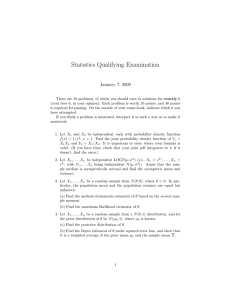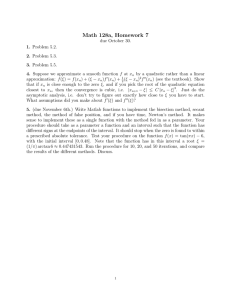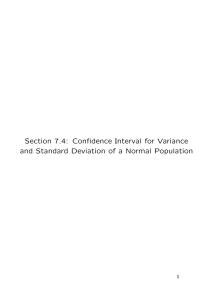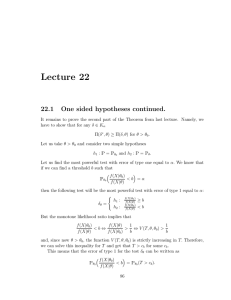Lecture 17 17.1 Confidence intervals for parameters of nor- mal distribution.
advertisement
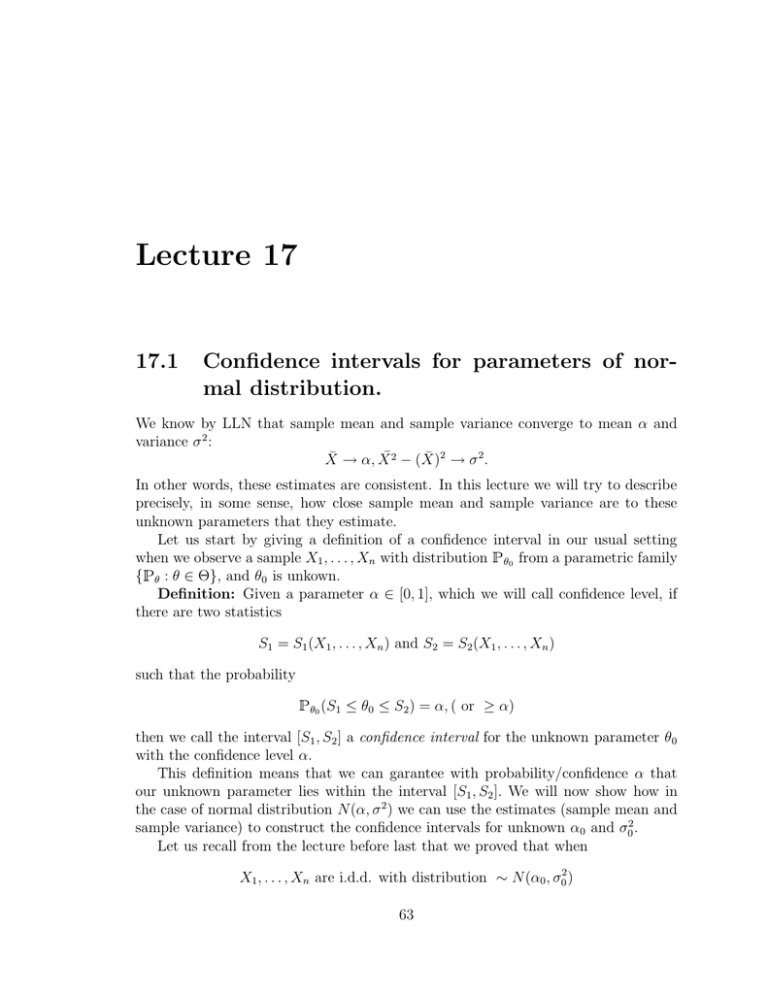
Lecture 17
17.1
Confidence intervals for parameters of normal distribution.
We know by LLN that sample mean and sample variance converge to mean α and
variance σ 2 :
X̄ → α, X̄ 2 − (X̄)2 → σ 2 .
In other words, these estimates are consistent. In this lecture we will try to describe
precisely, in some sense, how close sample mean and sample variance are to these
unknown parameters that they estimate.
Let us start by giving a definition of a confidence interval in our usual setting
when we observe a sample X1 , . . . , Xn with distribution θ0 from a parametric family
{ θ : θ ∈ Θ}, and θ0 is unkown.
Definition: Given a parameter α ∈ [0, 1], which we will call confidence level, if
there are two statistics
S1 = S1 (X1 , . . . , Xn ) and S2 = S2 (X1 , . . . , Xn )
such that the probability
θ0 (S1
≤ θ0 ≤ S2 ) = α, ( or ≥ α)
then we call the interval [S1 , S2 ] a confidence interval for the unknown parameter θ0
with the confidence level α.
This definition means that we can garantee with probability/confidence α that
our unknown parameter lies within the interval [S1 , S2 ]. We will now show how in
the case of normal distribution N (α, σ 2 ) we can use the estimates (sample mean and
sample variance) to construct the confidence intervals for unknown α0 and σ02 .
Let us recall from the lecture before last that we proved that when
X1 , . . . , Xn are i.d.d. with distribution ∼ N (α0 , σ02 )
63
64
LECTURE 17.
then
A=
√
n(X̄ 2 − (X̄)2 )
n(X̄ − α0 )
∼ χ2n−1
∼ N (0, 1) and B =
σ0
σ02
and the random variables A and B are independent. If we recall the definition of χ2
distribution, this mean that we can represent A and B as
A = Y1 and B = Y22 + . . . + Yn2
for some Y1 , . . . , Yn i.d.d. standard normal.
2
ΨN−1
(1−α) − Confidence Level
2
α
PDF
(1−α)
2
(1−α)
2
C1
C2
Figure 17.1: P.d.f. of χ2n−1 distribution and α confidence interval.
First, if we look at the p.d.f. of χ2n−1 distribution (see figure 17.1) and choose the
constants c1 and c2 so that the area in each tail is (1 − α)/2, since the area represents
the probability of the corresponding interval, we get that,
(B ≤ c1 ) =
1−α
and
2
(B ≥ c2 ) =
1−α
.
2
The remaining probability is
(c1 ≤ B ≤ c2 ) = α,
which means that we can garantee with probability α that
c1 ≤
n(X̄ 2 − (X̄)2 )
≤ c2 .
σ02
Solving this for σ02 gives
n(X̄ 2 − (X̄)2 )
n(X̄ 2 − (X̄)2 )
≤ σ02 ≤
.
c2
c1
65
LECTURE 17.
This precisely means that the interval
h n(X̄ 2 − (X̄)2 ) n(X̄ 2 − (X̄)2 ) i
,
c2
c1
is the α confidence interval for the unknown variance σ02 .
Next, let us construct the confidence interval for the mean α0 . Consider the following expression,
A
q
1
B
n−1
=q
Y1
1
(Y22
n−1
+ . . . + Yn2 )
∼ tn−1
which, by definition, has t-distribution with n − 1 degrees of freedom. On the other
hand,
√ (X̄−α0 )
n σ0
X̄ − α0
A
q
.
=q
=q
¯
2
2
1
1
1 n(X −(X̄) )
2 − (X̄)2 )
B
(
X̄
2
n−1
n−1
n−1
σ
0
If we now look at the p.d.f. of tn−1 distribution (see figure 17.2) and choose the
constants −c and c so that the area in each tail is (1 − α)/2, (the constant is the same
on each side because the distribution is symmetric) we get that with probability α,
α
PDF
(1−α)
2
(1−α)
2
−C
C
Figure 17.2: tn−1 distribution.
−c ≤ q
X̄ − α0
1
(X̄ 2
n−1
− (X̄)2 )
≤c
and solving this for α0 , we get the confidence interval
r
r
1
1
2
2
(X̄ − (X̄) ) ≤ α0 ≤ X̄ + C
(X̄ 2 − (X̄)2 ).
X̄ − c
n−1
n−1
66
LECTURE 17.
Example. (Textbook, Section 7.5, p. 411). Consider a normal sample of size
n = 10 :
0.86, 1.53, 1.57, 1.81, 0.99, 1.09, 1.29, 1.78, 1.29, 1.58.
We compute the estimates
X̄ = 1.379 and X̄ 2 − (X̄)2 = 0.0966.
Choose confidence level α = 95% = 0.95.
We have to find c1 , c2 and c as explained above. Using the table for t9 distribution
on page 776, we need to find c such that
t9 (−∞, c) = 0.975
which gives us c = 2.262. To find c1 and c2 we can use χ29 table on page 774,
χ29 ([0, c1 ]) = 0.025 ⇒ c1 = 2.7
χ29 ([0, c2 ]) = 0.975 ⇒ c2 = 19.02.
Plugging these into the formulas above, with probability 95% we can garantee
that
r
r
1 2
1 2
X̄ − c
(X̄ − (X̄)2 ) ≤ α0 ≤ X̄ + c
(X̄ − (X̄)2 )
9
9
0.6377 ≤ α0 ≤ 2.1203
and with probability 95% we can garantee that
n(X̄ 2 − (X̄)2 )
n(X̄ 2 − (X̄)2 )
≤ σ02 ≤
c2
c1
or
0.0508 ≤ σ02 ≤ 0.3579.
These confidence intervals may not look impressive but the sample size is very small
here, n = 10.


